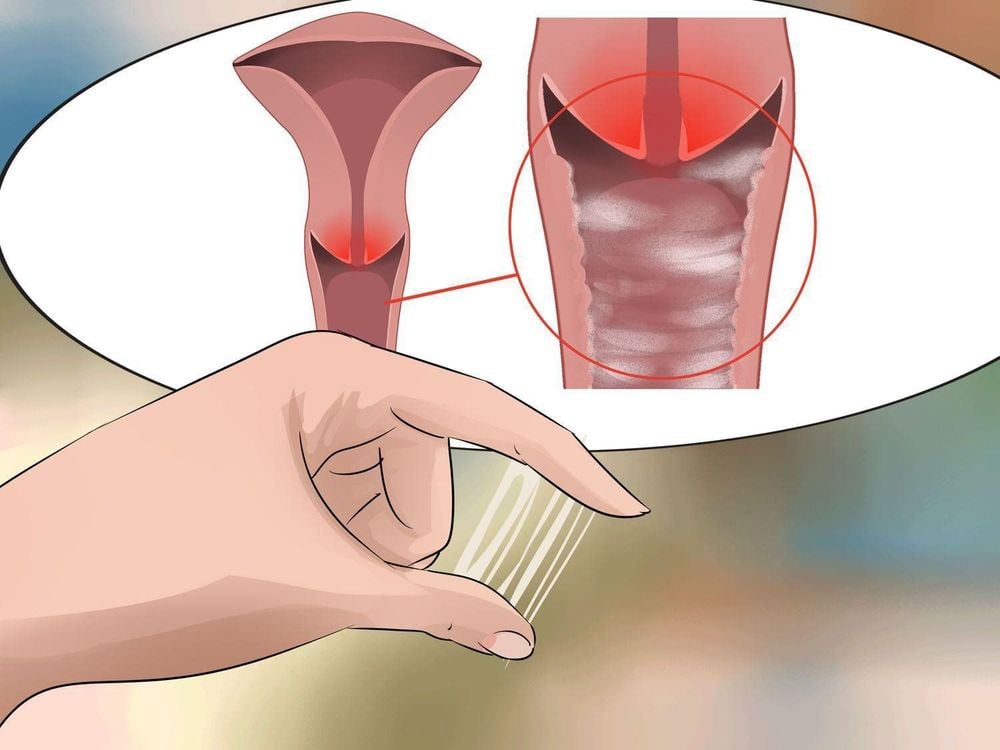This is an automatically translated article.
The article was professionally consulted with Specialist Doctor I Nguyen Thi Man - Obstetrician and Gynecologist - Department of Obstetrics and Gynecology - Vinmec Danang International General Hospital.Vaginal discharge is a normal physiological mechanism of the body to clean the vagina and prevent infection with pathogenic microorganisms. Abnormal vaginal discharge is one of the signs of a bacterial vaginosis. So how to recognize these and how to treat them? We will find out in the next article.
1. What is vaginal discharge?
Vaginal discharge is usually a normal and frequent phenomenon. Vaginal discharge serves an important hygienic function in the female reproductive system. The fluid produced by glands inside the vagina and cervix carries away dead cells and bacteria. This keeps the vagina clean and helps prevent infection.Most of the time, vaginal discharge is completely normal. The amount can vary, as can the smell and color (which can range from clear to milky), depending on the time of your menstrual cycle. For example, there will be more discharge when you are ovulating, breastfeeding, or sexually aroused. It may smell different when you're pregnant or you're leaving your personal hygiene alone.
However, there are certain types of discharge that can be a sign of an infection. Abnormal discharge may be yellow or green, thick, or foul-smelling.
Yeast or bacterial infections often cause abnormal discharge. If the color, smell, or consistency seems different than usual, especially if you also have vaginal itching or burning, you may have an infection or other condition. If you notice any discharge that looks unusual or has a bad odor or is itchy see your doctor for diagnosis and treatment.
2. Causes of abnormal vaginal discharge
Normal vaginal discharge is a healthy bodily function. It's your body's way of cleaning and protecting your vagina. For example, discharge that increases with sexual stimulation and ovulation is normal. Exercise, oral contraceptive use, and emotional stress can also lead to discharge.Any change in the normal bacterial balance of the vagina can affect the smell, color or texture of discharge. Here are some things that can upset that balance:
Use of antibiotics or steroids Bacterial vaginosis, a bacterial infection more common in pregnant women or women with many friends Contraception Pills Cervical cancer Chlamydia or gonorrhea (STDs), sexually transmitted infections Diabetes Detergents, scented soaps or shower gels, foaming baths Post-operative pelvic infections Illnesses pelvic inflammatory disease (PID) Trichomonas, a parasitic infection commonly acquired and caused by unprotected sex Vaginal atrophy, thinning, and dryness of the vaginal walls during menopause Vaginitis, irritation in the vagina or around the vagina Yeast infection.

2.2. Trichomonas Trichomonas is another type of infection. It is caused by a single-celled organism or a single-celled organism. The infection is usually spread through sexual contact, but it can also be acquired by sharing towels or bathing suits. It results in a yellow or green discharge with a foul odor. Pain, inflammation, and itching are also common symptoms, although some people do not experience any symptoms.
2.2. Yeast Infection A yeast infection is a fungal infection that produces a white, cheese-like discharge, along with an itching and burning sensation. The presence of yeast in the vagina is normal, but its growth can multiply out of control in certain cases. The following may increase the chance of a yeast infection:
Stress Diabetes Use of birth control pills Pregnancy Antibiotics, especially prolonged use for more than 10 days 2.3. Gonorrhea and chlamydia Gonorrhea and chlamydia are sexually transmitted infections (STIs) that can cause abnormal discharge. It is usually yellow, green, or opaque in color.
2.4. Pelvic inflammatory disease (PID) Pelvic inflammatory disease (PID) is an infection that is usually spread during sex. It occurs when bacteria spreads up the vagina and into other reproductive organs. It can produce a thick and foul-smelling discharge.

3. Types of vaginal discharge
There are several different types of vaginal discharge. These types are classified based on their color and consistency. Some types of discharge are normal. Others may indicate an underlying condition that requires treatment.3.1. White A slightly white discharge, especially at the beginning or end of your menstrual cycle, is normal. However, if the discharge is accompanied by itching and is thick or cheese-like, it is not normal and needs to be treated. This type of discharge could be a sign of a yeast infection.
3.2. Clear and Liquid Clear and liquid discharge is completely normal. It can happen at any time of the month. It can be especially heavy after exercise.
>>> What's wrong with transparent white discharge?
3.3. Clear and thick When the discharge is clear but thick and more like mucus than water, it indicates that you are ovulating. This is a normal discharge pattern.
3.4. Brown or Blood Brown or bloody discharge is usually normal, especially when it occurs during or shortly after your period. Late discharge at the end of your period may be brown instead of red. You may also experience some bleeding between periods. This is called spotting.
If spotting occurs during the normal period of your period and you recently had unprotected sex, this could be a sign of pregnancy. Bleeding in the early stages of pregnancy can be a sign of a miscarriage, so you should discuss it with your gynecologist.
In rare cases, brown or bloody discharge can be a sign of endometrial or cervical cancer. It could be other problems like fibroids or other abnormal tumors. This is why it's important to have an annual pelvic exam and cervical cytology test. Your gynecologist will check for abnormalities in the cervix during these procedures.
3.5. Yellow or green Discharge that is yellow or green, especially when it's thick, chewy, or is accompanied by an unpleasant odor is not normal. This type of discharge could be a sign of a trichomoniasis infection. It is usually spread through sexual contact.

4. How do doctors diagnose abnormal discharge?
Your doctor will start by taking your medical history and asking about your symptoms. Questions may include:When did the abnormal discharge begin? What color is the discharge? Is there any smell? Do you have itching, pain, or burning in or around your vagina? Do you have more than one sex partner? Do you douche? Your doctor may take a discharge sample or do a Pap test to collect cells from your cervix for further testing.
5. When should you seek medical help?
If you have unusual discharge along with some other symptoms, see your doctor as soon as possible. Symptoms to look out for include:Fever Abdominal pain Unexplained weight loss Fatigue Increased urination If you have any concerns about normal discharge make an appointment with your doctor. When you visit your doctor for unusual vaginal discharge, you'll get a general physical, including a pelvic exam. Your doctor will also ask you some questions about your symptoms, menstrual cycle, and sexual activity. In many cases, an infection can be detected by a physical or pelvic exam.
If your doctor cannot diagnose the problem right away, they may order some tests. Your doctor may want to take a curettage from your cervix to check for HPV or cervical cancer. Your discharge may also be examined under a microscope to identify an infectious agent. After your doctor can tell you the cause of the discharge, you will be presented with treatment options.

6. Vaginal discharge treatment
To prevent infection, practice good hygiene and wear breathable cotton underwear. Do not douche as they can make discharge worse by removing helpful bacteria. Also, practice safe sex and use protection to avoid sexually transmitted diseases.To reduce the chance of a yeast infection when taking antibiotics, eat yogurt that contains live and active bacteria. If you know you have a yeast infection, you can also treat it with an over-the-counter yeast infection topical or medication.
How you get treatment will depend on what's causing the problem. For example, yeast infections are often treated with antifungal medications inserted into the vagina in the form of a cream or gel. Bacterial vaginosis is treated with antibiotic pills or creams. Trichomoniasis is usually treated with the medications metronidazole (Flagyl) or tinidazole (Tindamax).
Here are some tips to prevent vaginal infections that can lead to abnormal discharge:
Keep your vagina clean by washing with mild soap and warm water outside. There is no need to put soap directly into the vagina. Never use scented soaps and feminine products or douche. In addition, you should also avoid feminine sprays and foam baths. After using the bathroom, always wipe from front to back to prevent bacteria from entering the vagina and causing an infection. Wear 100% cotton underwear and avoid clothing that is too tight. Basic gynecological examination and screening package at Vinmec International General Hospital for customers with abnormal symptoms such as: Abnormal vaginal bleeding; Menstrual problems; Abnormal vaginal discharge (with a bad smell, a different color than usual); Vaginal pain and itching....Female customers have several risk factors such as poor personal hygiene, unsafe sex, abortion, ..Female customers have other symptoms of infection ...
When registering for the basic gynecological examination and screening package at Vinmec, you can perform ultrasound and examination techniques for early detection of inflammatory diseases for easy treatment. costly; Screening for early detection of gynecological cancer.
Please dial HOTLINE for more information or register for an appointment HERE. Download MyVinmec app to make appointments faster and to manage your bookings easily.
Article reference source: webmd.com













